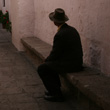Posted in Peru on Jan 5th, 2009

|
|
Going to Church.
|
A strong grip – Malevolent forces – Pishtacos – Bloody Illustrations
Sometimes when I read a book it gets a hold on me and I can’t stop thinking about it. About three weeks ago I read “A Death in the Andes“, by Mario Vargas Llosa, and The themes explored by the Peruvian author have had quite an impact on me. The novel is set in 1980’s Peru, at a time when the Sendero Luminoso or Shining Path was active.
Read Full Post »
Posted in Peru, Videoblog on Oct 11th, 2008
The worst hike – The Colca Canyon – Andean Condor – Reward for diligence. (Map this!) You know that you are on the worst hike in the world when You start the off not feeling well and know that you probably shouldn’t be hiking in the first place. Your expectations of an easy hike are […]
Read Full Post »
Posted in A Long Drive, Peru, South America on Oct 6th, 2008

|
|
At Santa Catalina
|
Gang aft agley – Drug Policy – Not adding to the tally – Perturbations
I am very happy that my parents are able to visit us here in Peru. But as I write this we are not with them – they are in the flatlands of the Peruvian coastal desert and we are in the heights of the Colca Canyon. As much as they would like to come to the Colca, they cannot, because in Daddy’s opinion he is suffering from the effects of altitude. Hence they have fled, for now, to sea level for “personal reasons”. Not a drastic situation, but an example of the best laid plans gang aft agley…
Read Full Post »
Posted in Peru on Oct 2nd, 2008
Suhas Taskar Paucartambo – Cock of the rock – Manu Biosphere Reserve – Macaw clay lick – Hardship Starting from Cusco we passed through the Andes, stopping at the village of Paucartambo where we made a brief stop to view the display of statues made of bronze. Each statue signifies a role played by the […]
Read Full Post »
Posted in Peru on Sep 29th, 2008

|
|
Manu National Park
|
Aggressive trees – Egrets, Caiman and butterflies – Hot monkeys – Insects everywhere – Impact of tourism and accessibility
With gigantic roots like sails, the kapok tree stands upright by reaching very far but not deep to search for nutrients in the top layer of the earth. The strangler fig embraces its host tree for support until its own roots are strong enough, then eventually strangles it. The “walking tree” has stilt like roots that actually allow it to move a few feet in search of precious nutrients. Some palms grow spines on their trunk to fend off animals while their fruit develop. These fall off later when the fruit are ripe and the tree is ready for pollination. Other trees host fire ants for protection and woe betide anyone who comes within (ant) jumping distance of the tree!
Read Full Post »


